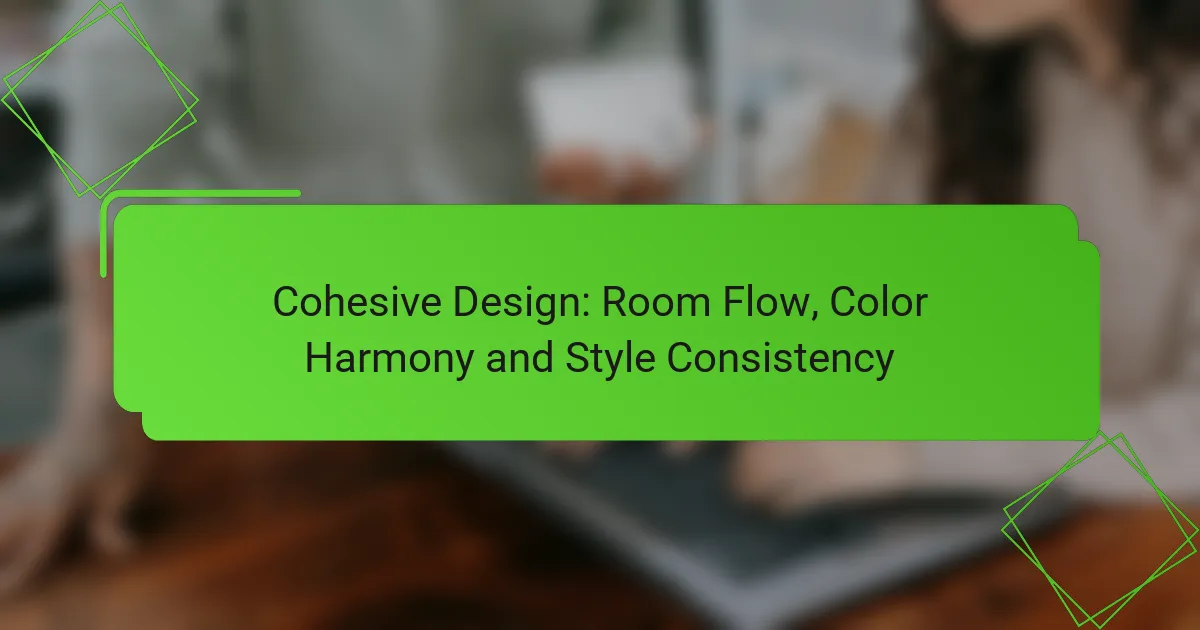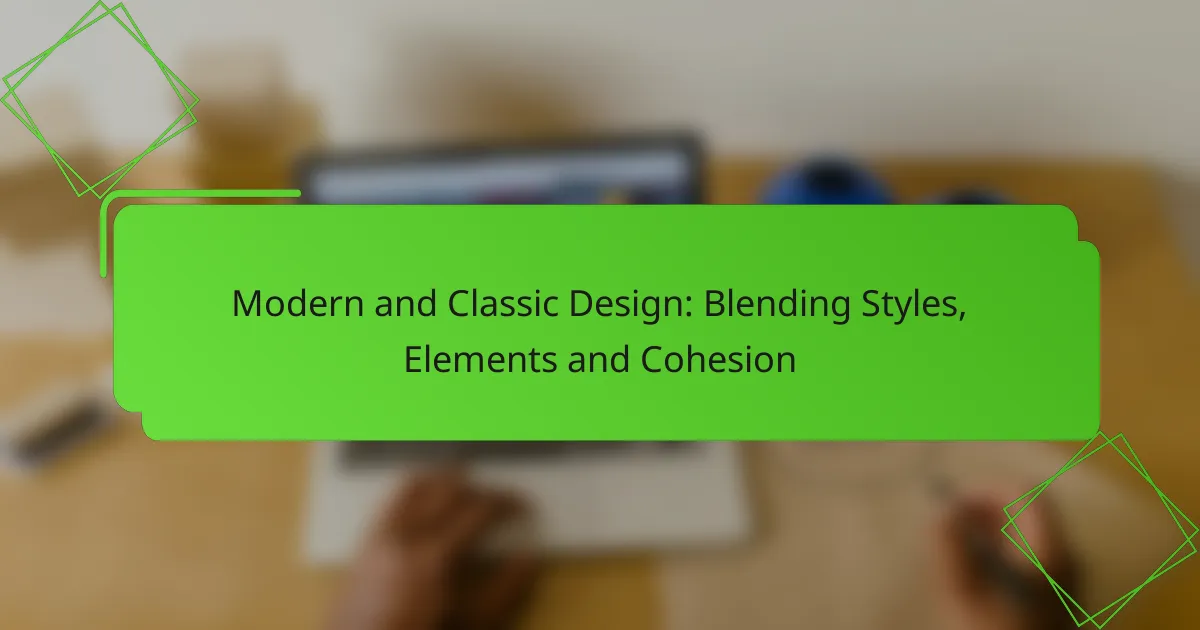Cohesive design in Irish homes is achieved by ensuring a harmonious flow between spaces, utilizing a consistent color palette, and selecting complementary furniture. This thoughtful approach not only enhances the aesthetic appeal but also improves the functionality and comfort of your living environment. By prioritizing room flow and color harmony, you create inviting spaces that reflect a unified style throughout your home.

How to achieve cohesive design in Irish homes?
To achieve cohesive design in Irish homes, focus on creating a harmonious flow between spaces, using a consistent color palette, and selecting furniture that complements each other. This approach enhances the overall aesthetic and functionality of your living environment.
Utilize open floor plans
Open floor plans promote seamless transitions between different areas of the home, making spaces feel larger and more connected. Consider removing non-structural walls to create a unified living, dining, and kitchen area, which encourages interaction and movement.
When designing an open space, ensure that each zone is visually distinct yet cohesive. Use furniture arrangement and color to define areas while maintaining an overall flow that ties them together.
Incorporate natural light
Natural light enhances the ambiance and warmth of a home, making it feel inviting and spacious. Maximize sunlight by using large windows, glass doors, or skylights, especially in common areas where family and friends gather.
Consider the orientation of your home when planning for natural light. South-facing windows typically receive the most sunlight throughout the day, which can help reduce energy costs and improve mood.
Choose complementary furniture styles
Selecting furniture that shares similar design elements fosters a cohesive look. Aim for pieces that complement each other in style, color, and material, creating a harmonious environment throughout the home.
Mixing styles can work if done thoughtfully. For example, pairing modern furniture with vintage accents can create an eclectic yet cohesive feel, as long as the color palette remains consistent.
Maintain consistent flooring
Using the same flooring material throughout your home enhances visual continuity. Whether you choose hardwood, tile, or laminate, consistent flooring creates a unified look that ties different spaces together.
If different materials are necessary for practical reasons, such as moisture in bathrooms, ensure they complement each other in color and texture to maintain a cohesive design.
Use area rugs for definition
Area rugs can help define spaces within an open floor plan while adding warmth and texture. Choose rugs that complement your overall color scheme and style, ensuring they are appropriately sized for the areas they define.
For instance, a large area rug can anchor a seating arrangement, while smaller rugs can delineate spaces in a dining area. This strategy enhances flow and creates a sense of organization in open layouts.

What are the principles of room flow?
Room flow refers to the ease with which people can move through a space, influenced by layout, furniture arrangement, and overall design. Effective room flow enhances functionality and comfort, making spaces feel more inviting and organized.
Define pathways for movement
Establishing clear pathways for movement is essential for facilitating easy navigation within a room. Aim for at least 24 inches of clearance in high-traffic areas to prevent congestion and ensure comfort. Consider the natural flow of activities, such as walking from a seating area to a dining table.
Use rugs or furniture arrangement to visually define these pathways, guiding movement without obstructing it. Avoid placing furniture too close together, which can create barriers and disrupt the flow.
Balance furniture placement
Balancing furniture placement involves distributing pieces evenly throughout the room to create a harmonious look. Avoid clustering all large items in one area, as this can lead to a lopsided feel. Instead, mix sizes and shapes to achieve visual equilibrium.
Consider the scale of your furniture in relation to the room size. For instance, oversized sofas may overwhelm a small space, while smaller pieces can get lost in larger rooms. Aim for a mix of heights and forms to keep the eye moving and maintain interest.
Create focal points in each room
Focal points draw attention and anchor the design of a room, making it feel cohesive. Common focal points include fireplaces, artwork, or large windows. Position furniture to highlight these elements, ensuring they are easily visible upon entering the space.
To enhance the impact of a focal point, use complementary colors and textures in surrounding decor. Avoid cluttering the area with too many competing elements, which can dilute the focal point’s effect and disrupt the overall flow of the room.

How to select a color palette for harmony?
Selecting a color palette for harmony involves choosing colors that complement each other and create a cohesive look throughout a space. A well-chosen palette enhances the overall aesthetic and can influence mood and perception within the room.
Choose a dominant color
The dominant color sets the tone for the room and should be the most prominent shade in your design. Consider using neutral tones like beige, gray, or soft pastels for a calming effect, or bold colors like navy or emerald for a more dramatic impact. Aim for about 60% of the room’s color to be this dominant shade.
Incorporate accent colors
Accent colors are used to add interest and contrast to your dominant color. Typically, these should make up about 30% of your palette. Choose two to three accent colors that complement your dominant shade; for instance, if your dominant color is a soft blue, consider using coral or mustard as accents.
Use color theory basics
Understanding color theory can significantly enhance your palette selection. Utilize the color wheel to find complementary colors (opposite each other) or analogous colors (next to each other) for a harmonious look. For example, pairing green with blue can create a serene atmosphere, while red and green can add vibrancy.
Consider lighting effects on colors
Lighting plays a crucial role in how colors appear in a room. Natural light can make colors look different throughout the day, while artificial light can alter their warmth or coolness. Test paint samples under various lighting conditions to see how they interact with your chosen colors before making a final decision.

What styles promote consistency in design?
Styles that promote consistency in design create a cohesive look and feel throughout a space. This can be achieved through the careful selection of colors, materials, and furnishings that align with a specific aesthetic or theme.
Modern minimalist approach
The modern minimalist approach emphasizes simplicity and functionality, often featuring clean lines and a limited color palette. This style promotes consistency by reducing visual clutter and focusing on essential elements, which can make a space feel more open and organized.
Key considerations include using neutral colors like whites, grays, and blacks, complemented by natural materials such as wood and metal. Avoid excessive decoration; instead, choose a few statement pieces that align with the minimalist ethos.
Scandinavian design elements
Scandinavian design elements prioritize comfort, simplicity, and a connection to nature, often utilizing light colors and natural materials. This style fosters consistency through its emphasis on functionality and a harmonious blend of aesthetics and practicality.
Incorporate light woods, soft textiles, and a neutral color scheme with pops of muted tones. Aim for a balance between form and function, ensuring that each piece serves a purpose while contributing to the overall cohesive look.
Traditional Irish decor
Traditional Irish decor is characterized by rich textures, warm colors, and handcrafted elements, promoting a sense of warmth and nostalgia. This style achieves consistency through the use of rustic materials and patterns that reflect Ireland’s cultural heritage.
Consider using stone, wood, and wool in your furnishings and decor, along with colors inspired by the Irish landscape, such as deep greens and earthy browns. Incorporate traditional patterns like Celtic knots or tartans to enhance the cohesive feel of the space.

What are the benefits of cohesive design?
Cohesive design creates a unified look and feel across a space, enhancing both its beauty and functionality. This approach fosters a seamless flow between rooms, promotes harmony in color schemes, and maintains consistency in style, leading to a more enjoyable environment.
Enhances aesthetic appeal
A cohesive design significantly boosts the visual attractiveness of a space. By using a consistent color palette and complementary styles, rooms feel more inviting and well-thought-out. For instance, selecting a limited range of colors for walls, furniture, and decor can create a serene atmosphere that draws people in.
Consider using accent pieces that reflect the main color scheme to tie different areas together. This could include throw pillows, artwork, or decorative items that echo the primary colors of the room, enhancing the overall aesthetic without overwhelming the senses.
Improves functionality
Cohesive design not only looks good but also enhances the functionality of a space. When rooms flow well together, it becomes easier to navigate and use them effectively. For example, an open floor plan that maintains a consistent style allows for better movement between the kitchen and living area, making daily activities more efficient.
To improve functionality, consider the layout and how each area interacts with others. Ensure that furniture placement facilitates easy movement and that there are no awkward transitions between spaces. This can be achieved by using similar materials and colors to create a visual connection.
Increases property value
A well-executed cohesive design can significantly increase the value of a property. Buyers are often drawn to homes that present a harmonious and stylish appearance, as it suggests that the space has been well cared for. A cohesive aesthetic can lead to quicker sales and higher offers in competitive markets.
When preparing a home for sale, focus on enhancing the cohesion of design elements. This might include repainting rooms in neutral tones, updating fixtures to match, and ensuring that all spaces feel connected. Investing in cohesive design can yield returns that far exceed the initial costs, making it a smart choice for homeowners.



